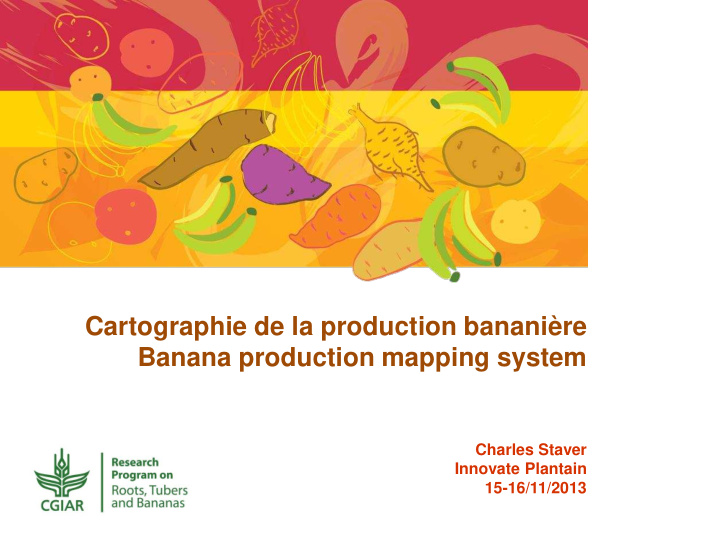



Cartographie de la production bananière Banana production mapping system Charles Staver Innovate Plantain 15-16/11/2013
Why document & map banana production? • Access to reliable data on crop production is needed for effective planning and setting of priorities in R&D • The aim of this exercise is to improve, to make available and to share spatial information on global banana production
Online mapping tool • To store this information an online mapping tool with an associated data base, accessible for everyone, is set up (www.crop-mapper.org/banana).
Procedure to collect data in 2 steps Step 1: Draw on a map the primary banana growing areas in the country and indicate the respective production systems for each area Produ oduction ion systems Predominant t cultivar ar group Crop associati ations and duration or cultivar ar present: 1 Cavendish AAA 1 Associated with established 2 Gros Michel AAA perennial crops like coffee, 3 other AAA dessert types coconut, etc 4 East African Highland AAA 2 Annual food crop association 5 Plantain AAB intercropped with Musa (2-5 6 other AAB, including South years) Pacific plantains 3 Perennial Musa planting mixed 7 ABB cooking bananas with annual crops 8 Diploid types 4 Musa field (2-5 years) with short term annual crop intercropped during Musa establishment 5 Perennial Musa monocrop 6 Frequently replanted Musa monocrop
Procedure to collect data in 2 steps Step 2: Consolidate existing data on the production area, total production and nature of production technologies and limiting biotic factors for each of the production systems by area Guide with questions Excel answer sheet Country map
Use guide to fill out excel sheet … Total land area in this production system in the marked area: 6 Number of hectares: ______ 7 Production/ha/year for production system: _____ tons/ha/year 8 Total production for area (: ___ tons/year (calculated with production/ha x number of hectares) 9 Average Musa density of mats/ha in the production system: ____ mats/ha 10 Number of households using this production system in the marked area: ____ 11 How is the production used: ____ 0: primarily home consumption (>80%); 1: home consumption and market; 2: primarily market (>80%); 12 In the past 5 years the area under production is: 1: decline. 2: stable. 3: increasing 13 In the past 5 years yield per hectare is: 1: declining. 2: stable. 3: increasing Technology used: 14 General level of use of purchased production inputs (nutrients, pesticides, irrigation): ________ 0: none or very occasional use; 1: regular use of low levels of fertilizer, pesticides or irrigation; 2: regular use of moderate levels of fertilizer, pesticides or irrigation; 3: regular use of high levels of fertilizer, pesticides or irrigation; 4: certified organic production 15 Irrigation: ____ 0: no irrigation used; 1: occasional irrigation to maintain minimal plant growth in periods of deficit; 2: regular irrigation, although periods of water deficit several times per year ; 3: irrigation to eliminate any stress due to water deficits For those production systems with regular use of purchased inputs: 16 Average use of chemical fertilizer nitrogen kg/ha/year ____ 17 Average use of organic fertilizer nitrogen kg/ha/year ____ Frequency of use of pesticides: 18 Herbicides ____ 19 Fungicides ____ 20 Nematicides ____ 21 Insecticides _____ 0: no use - 1: at least once a year - 2: 2-3 times/year - 3: >3 times/year Primary pest and disease problems (rank level of importance) : 0 – not present, 1 – present, but very little impact on yields (<5%), 2 – limited impact on yields or plantation life (5-10%), 3 - moderate impact on yields or plantation life 10-25%), 4 - severe impact on yields or plantation life (>25%) Pest/disease Importance Nematodes 22 P. goodeyi _____ 23 P. coffeae _____ 24 R. similis _____ 25 Meloidogyne spp _____ 26 H. multicinctus _____ …
Send the data to: • Geert Claessens: g.claessens@cgiar.org • Claudine Picq: c.picq@cgiar.org Any questions? Thank you!
Recommend
More recommend